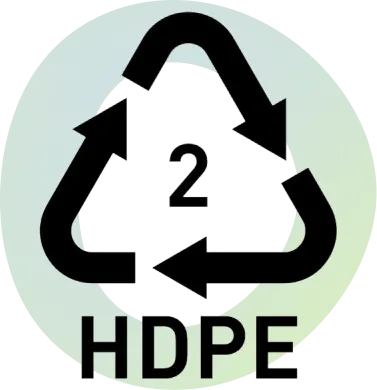High-Density Polyethylene (HDPE)
High-Density Polyethylene (HDPE) Recycling
Reclaim
High-density polyethylene, often referred to as “HDPE”, or “PE-HD”, is a widely recyclable and commonly used thermoplastic in both consumer and industrial applications, due to its high tensile strength, impact-resistance, and strength-density ratio [1]. This strength can be attributed to its molecular structure which contains very few branching sidechains, increasing density and tensile strength.
Additionally, due to the availability of FDA-approved, food-safe HDPE, it is commonly found in plastic bottles and milk jugs, in addition to plastic crates, detergent and bleach bottles, and much more.
Furthermore, HDPE is also highly malleable once melted, allowing for it to be molded into a variety of shapes, such as the aforementioned HDPE crates which are entirely composed of the material. Due to its high relative melting point, it can be boiled without losing structural integrity, facilitating sterilization in food-grade consumer products. Its corrosion and oil resistant properties also leave it suitable for containing stronger chemical agents such as bleach [1].
HDPE is also highly recyclable – it is accepted by street pick-up recycling services almost worldwide [2] and can be used in the production of new products whose quality nearly approaches that of virgin resin. Some studies suggest that the injection and shredding processes involved in rigid plastics recycling have few property-altering effects on HDPE, leading to conclusions that virgin HDPE can be recycled up to 10 times before needing to be replaced [3].
Seeing as HDPE and PET account for 97% of all manufactured plastic bottles in North America, combined with their conduciveness to being recycled, efforts to encourage the use of recycled HDPE in new manufacturing processes shouldn’t be overlooked.

HDPE has a resin identification code of 2.
References
[1] ACME plastics, “What is High Density Polyethylene (HDPE)? | Acme Plastics,” Acmeplastics.com, 2020. https://www.acmeplastics.com/what-is-hdpe (accessed Jul. 28, 2021).
[2] Plastic Action Center, “Plastic by the Numbers,” Plasticactioncentre.ca, 2019. https://plasticactioncentre.ca/directory/plastic-by-the-numbers/ (accessed Jul. 28, 2021).
[3] C. Goldsberry, “Scientific tests prove HDPE can be recycled at least 10 times,” plasticstoday.com, Jan. 24, 2018. https://www.plasticstoday.com/packaging/scientific-tests-prove-hdpe-can-be-recycled-least-10-times (accessed Jul. 28, 2021).

Carstar
“We are proud to recycle our scrap bumper plastics rather than add to the landfill. Reclaim has helped us do this.”
Kris Kurman
Manager
Schedule an appointment today!
Reclaiming our environment by Reclaiming the plastic waste we produce.

